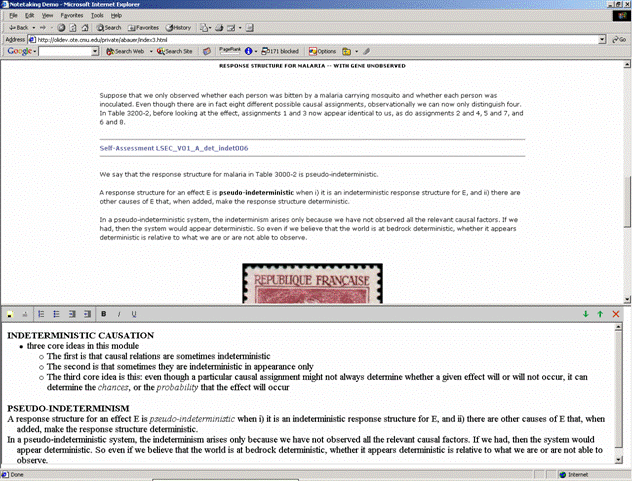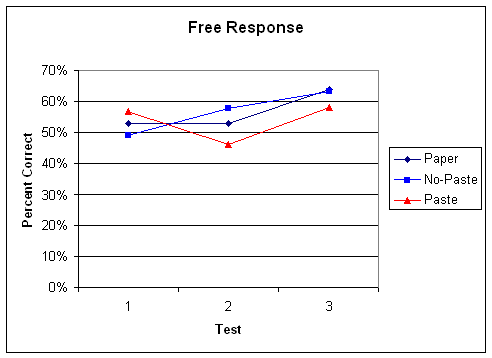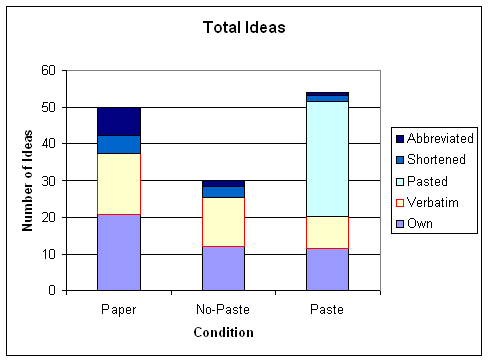Difference between revisions of "Note-Taking: Copy Paste"
(→Dependent Variables) |
|||
| (12 intermediate revisions by 2 users not shown) | |||
| Line 1: | Line 1: | ||
| + | === Summary Table === | ||
| + | {| border="1" cellspacing="0" cellpadding="5" style="text-align: left;" | ||
| + | | '''PIs''' || Aaron Bauer & Kenneth R. Koedinger | ||
| + | |- | ||
| + | | '''Other Contributers''' || | ||
| + | |- | ||
| + | | '''Study Start Date''' || March 1, 2005 | ||
| + | |- | ||
| + | | '''Study End Date''' || June 10, 2005 | ||
| + | |- | ||
| + | | '''Laboratory Study''' || | ||
| + | |- | ||
| + | | '''LearnLab Course''' || Causal and Statistical Reasoning (OLI) | ||
| + | |- | ||
| + | | '''Number of Students''' || 69 | ||
| + | |- | ||
| + | | '''Total Participant Hours''' || 207 | ||
| + | |- | ||
| + | | '''DataShop''' || Log data is not in DataShop. Should be available Fall 2007 | ||
| + | |} | ||
| + | <br> | ||
| + | |||
== Abstract == | == Abstract == | ||
| Line 19: | Line 41: | ||
In a previous study (Bauer & Koedinger, 2005), we found that the inclusion of copy-paste functionality in a note-taking application appears to alter behavior when compared with taking handwritten notes. Students took advantage of copy-paste functionality to increase the number of words they recorded. They did not perform differently on an immediate multiple-choice post-test, however. | In a previous study (Bauer & Koedinger, 2005), we found that the inclusion of copy-paste functionality in a note-taking application appears to alter behavior when compared with taking handwritten notes. Students took advantage of copy-paste functionality to increase the number of words they recorded. They did not perform differently on an immediate multiple-choice post-test, however. | ||
| − | The study reported | + | The study reported here was aimed at understanding the effect of copy-paste functionality in greater detail. It included both multiple-choice and free-response problem solving questions, as well as [[robust learning]] measures of [[long-term retention]]. Students were tested immediately, at a one week delay, and at a one week delay after being allowed to review their notes. |
| − | Students were placed in one of three conditions, corresponding to the note-taking tool they were given. Some students took notes using pencil-and-paper. Others took notes using a text-editor that did not allow copy-paste. The final group took notes using a text-editor that allowed both typing and copy-paste. | + | Students were placed in one of three conditions, corresponding to the note-taking tool they were given. Some students took notes using pencil-and-paper. Others took notes using a text-editor that did not allow copy-paste. The final group took notes using a text-editor that allowed both typing and copy-paste. |
== Dependent Variables == | == Dependent Variables == | ||
| Line 29: | Line 51: | ||
[[Note:]] all tests include both multiple choice and free response questions. The multiple choice questions all involve solving problems (for example, given a response structure, which variables are direct causes of an effect, or which interact to produce an effect). In addition, some free response questions ask students to explain terminology used in the module. | [[Note:]] all tests include both multiple choice and free response questions. The multiple choice questions all involve solving problems (for example, given a response structure, which variables are direct causes of an effect, or which interact to produce an effect). In addition, some free response questions ask students to explain terminology used in the module. | ||
| − | ''Normal | + | ''[[Normal post-test]]:'' Students are given a test immediately after studying the material. |
| − | ''Long- | + | ''[[Long-term retention]]:'' Students return a week following the treatment (which lasts between 30 and 90 minutes) to take this test. |
| − | '' | + | ''[[Long-term retention]] after review:'' After taking the long-term retention test, students are given their notes to review for 5 minutes. Following this review period, students take a final test. |
| Line 49: | Line 71: | ||
== Independent Variables == | == Independent Variables == | ||
| + | [[image:NT-TextEditor.gif]] | ||
| + | |||
| + | ''This is the basic note-taking text-editor. Built in javascript, the editor occupies the lower third of the screen, while the learning materials occupy the top of the screen. The functionality of various manipulations is described below. | ||
'''Note-taking Treatment''' | '''Note-taking Treatment''' | ||
| − | ''Paste:'' Students can | + | ''Paste:'' Students can create notes by copy-pasting any amount of material from the learning content to their notepad or by typing in the notepad. |
| − | |||
| − | |||
''Typing:'' Students can only create notes by typing directly into their notepad. | ''Typing:'' Students can only create notes by typing directly into their notepad. | ||
| − | '' | + | ''Pencil-and-Paper:'' Students take notes using either an pencil or pen on either lined or unlined paper. |
| − | |||
| − | |||
| − | |||
'''Context/Mediating Variables on Student Characteristics''' | '''Context/Mediating Variables on Student Characteristics''' | ||
''SAT Score:'' All students are asked to provide their SAT scores, as in previous studies SAT-Math was found to be an important covariate. | ''SAT Score:'' All students are asked to provide their SAT scores, as in previous studies SAT-Math was found to be an important covariate. | ||
| − | |||
| − | |||
''Preferences:'' In the survey, students are asked how they prefer to take notes in their regular student-life. | ''Preferences:'' In the survey, students are asked how they prefer to take notes in their regular student-life. | ||
== Hypotheses == | == Hypotheses == | ||
| − | + | # Students using the copy-paste tool to take notes will take more notes than students typing or using pencil-and-paper. | |
| − | + | # Students using copy-paste to take notes will learn less than students typing or using pencil-and-paper, as their notes will be less personal. | |
| − | |||
== Findings == | == Findings == | ||
| − | [[Image:NT- | + | [[Image:NT-Exp2-FRLearn.gif]] |
| − | |||
| − | |||
| − | |||
| − | |||
| − | *'' | + | *''Learning:'' No statistically significant difference was found on individual tests. A significant time by condition interaction was found between the immediate and delayed (1 and 2) tests for free response questions. Students using copy-paste functionality forgot more than students using the typing tool or pencil-and-paper. |
| + | [[Image:NT-Exp2-Ideas.gif]] | ||
| − | + | *''Ideas:'' Students using the typing tool recorded fewer notes than the other tools, which were not significantly different. | |
| + | **''Wording:''Students using the copy-paste tool recorded significantly more ideas verbatim than the other tools. Most of these verbatim ideas were recorded using copy-paste functionality. Pencil-and-paper recorded significantly more ideas in own words. | ||
| − | * | + | * The copy-paste tool recorded far wordier ideas than either of the other tools. Ideas pasted using more words were associated with increased forgetting relative to ideas that were pasted using fewer words. |
| − | + | * There was not a significant difference with regards to completion time. | |
| − | * | ||
== Explanation == | == Explanation == | ||
| − | *The | + | * The copy-paste tool appears to result in both increased verbatim note-taking and reduced [[long-term retention]]. Copy-paste may thus be a negative behavior, potentially allowing students to record ideas in their notes without paying much attention to them. |
| − | + | * Students will take advantage of copy-paste functionality when available. While students in the copy-paste condition could type, the overwhelming proportion of their notes were pasted. | |
| − | * | ||
| − | |||
== Descendents == | == Descendents == | ||
| + | [[Note-Taking_Technologies|Note-taking project page]] | ||
| − | [[Note-Taking: | + | [[Note-Taking: Restriction and Selection]] |
== Further Information == | == Further Information == | ||
Bauer, A., and Koedinger, K. “Developing a Note Taking Tool from the Ground Up”. Ed-Media 2005. AACE Press, 4181-4186. | Bauer, A., and Koedinger, K. “Developing a Note Taking Tool from the Ground Up”. Ed-Media 2005. AACE Press, 4181-4186. | ||
| − | Bauer, A., Koedinger, K.R. Pasting and Encoding: Note-taking in Online Courses. In Proc. IEEE ICALT 2006. 789-793 | + | Bauer, A., Koedinger, K.R. Pasting and Encoding: Note-taking in Online Courses. In Proc. IEEE ICALT 2006. 789-793 [http://www.learnlab.org/uploads/mypslc/publications/471bau.doc Word File, Published Version] |
Latest revision as of 23:31, 14 April 2007
Contents
Summary Table
| PIs | Aaron Bauer & Kenneth R. Koedinger |
| Other Contributers | |
| Study Start Date | March 1, 2005 |
| Study End Date | June 10, 2005 |
| Laboratory Study | |
| LearnLab Course | Causal and Statistical Reasoning (OLI) |
| Number of Students | 69 |
| Total Participant Hours | 207 |
| DataShop | Log data is not in DataShop. Should be available Fall 2007 |
Abstract
In a previous study, we found that including copy-paste functionality in a note-taking application appears to be used to increase the quantity of notes students take. In this study (reported in Bauer & Koedinger, 2006) we conducted further evaluations of copy-paste functionality by conducting additional testing and comparing a text-editor that allowed copy-paste with two control conditions, a text-editor that did not allow copy-paste and pencil-and-paper. We found that compared with both control conditions, students given the ability to copy-paste created notes of a far more wordy and verbatim form. Students who could only type took fewer notes than students in the other conditions. While there was no performance difference on individual tests, students using the copy-paste tool appeared to show reduced long-term retention, forgetting more between the immediate and delayed test.
For information on the note-taking project see the top-level page.
Glossary
Select/ion: This term is used in the context of this study to identify the behavior of using the mouse and cursor to actively highlight a portion of digital text. Selection is first step for several online note-taking techniques, including copy-paste and annotation.
Copy-Paste: This is the act of selecting material, copying it to the computer clipboard (via a keyboard shortcut or menu), and then pasting it into students’ notes.
Research Question
Can we improve learning outcomes in online courses by changing the way students can take notes?
Background/Significance
In a previous study (Bauer & Koedinger, 2005), we found that the inclusion of copy-paste functionality in a note-taking application appears to alter behavior when compared with taking handwritten notes. Students took advantage of copy-paste functionality to increase the number of words they recorded. They did not perform differently on an immediate multiple-choice post-test, however.
The study reported here was aimed at understanding the effect of copy-paste functionality in greater detail. It included both multiple-choice and free-response problem solving questions, as well as robust learning measures of long-term retention. Students were tested immediately, at a one week delay, and at a one week delay after being allowed to review their notes.
Students were placed in one of three conditions, corresponding to the note-taking tool they were given. Some students took notes using pencil-and-paper. Others took notes using a text-editor that did not allow copy-paste. The final group took notes using a text-editor that allowed both typing and copy-paste.
Dependent Variables
Tests
Note: all tests include both multiple choice and free response questions. The multiple choice questions all involve solving problems (for example, given a response structure, which variables are direct causes of an effect, or which interact to produce an effect). In addition, some free response questions ask students to explain terminology used in the module.
Normal post-test: Students are given a test immediately after studying the material.
Long-term retention: Students return a week following the treatment (which lasts between 30 and 90 minutes) to take this test.
Long-term retention after review: After taking the long-term retention test, students are given their notes to review for 5 minutes. Following this review period, students take a final test.
Behavior
Note-Quantity: The total number of ideas students place in their notes is captured, as well as the number of words used to express those ideas.
Note-Wording: How students word their notes is recorded. Each ideas is either recorded Verbatim, Abbreviated, or in students Own words.
Completion Time: The time students take to complete the learning material is recorded.
Motivation/Interest
Experience: After taking the final test, students are given a survey which solicits their reaction to the tool they used. They are asked to identify their most and least favorite features of the tools, and how they believe the tool affected their note-taking behavior.
Independent Variables
This is the basic note-taking text-editor. Built in javascript, the editor occupies the lower third of the screen, while the learning materials occupy the top of the screen. The functionality of various manipulations is described below.
Note-taking Treatment
Paste: Students can create notes by copy-pasting any amount of material from the learning content to their notepad or by typing in the notepad.
Typing: Students can only create notes by typing directly into their notepad.
Pencil-and-Paper: Students take notes using either an pencil or pen on either lined or unlined paper.
Context/Mediating Variables on Student Characteristics
SAT Score: All students are asked to provide their SAT scores, as in previous studies SAT-Math was found to be an important covariate.
Preferences: In the survey, students are asked how they prefer to take notes in their regular student-life.
Hypotheses
- Students using the copy-paste tool to take notes will take more notes than students typing or using pencil-and-paper.
- Students using copy-paste to take notes will learn less than students typing or using pencil-and-paper, as their notes will be less personal.
Findings
- Learning: No statistically significant difference was found on individual tests. A significant time by condition interaction was found between the immediate and delayed (1 and 2) tests for free response questions. Students using copy-paste functionality forgot more than students using the typing tool or pencil-and-paper.
- Ideas: Students using the typing tool recorded fewer notes than the other tools, which were not significantly different.
- Wording:Students using the copy-paste tool recorded significantly more ideas verbatim than the other tools. Most of these verbatim ideas were recorded using copy-paste functionality. Pencil-and-paper recorded significantly more ideas in own words.
- The copy-paste tool recorded far wordier ideas than either of the other tools. Ideas pasted using more words were associated with increased forgetting relative to ideas that were pasted using fewer words.
- There was not a significant difference with regards to completion time.
Explanation
- The copy-paste tool appears to result in both increased verbatim note-taking and reduced long-term retention. Copy-paste may thus be a negative behavior, potentially allowing students to record ideas in their notes without paying much attention to them.
- Students will take advantage of copy-paste functionality when available. While students in the copy-paste condition could type, the overwhelming proportion of their notes were pasted.
Descendents
Note-Taking: Restriction and Selection
Further Information
Bauer, A., and Koedinger, K. “Developing a Note Taking Tool from the Ground Up”. Ed-Media 2005. AACE Press, 4181-4186. Bauer, A., Koedinger, K.R. Pasting and Encoding: Note-taking in Online Courses. In Proc. IEEE ICALT 2006. 789-793 Word File, Published Version


